CRG Research Report - © 2006-2024, Camaro Research Group
First Generation Camaro Carburetors
Author -
and the CRG
Reviewed by the CRG
Last Edit: 25-Oct-2013
Previous Edits: 17-Nov-2008, 12-Mar-2008, 19-Dec-2007
Original Release: 30-Nov-2007
|
Index
Introduction and History
Three companies supplied carburetors for 1967 through 1969 Camaro
usage: Rochester Products, Carter, and Holley.
Rochester Products plant, circa 1953
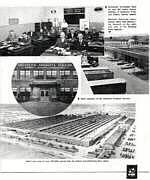 |
National Cycle Manufacturing Company,
Bay City, MI, circa 1898
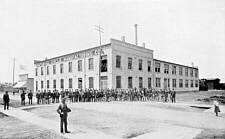 |
Most first-generation Camaro carburetors were supplied by the Rochester Products
Division of General Motors. Rochester Products Division has been operating since
production began at the then-new Lexington Avenue plant in Rochester, New York in 1939.
Originally a division of Delco Appliance, Rochester Products Division manufactured
tubing, automotive locks and keys, carburetors and a host of other automotive
components. Eventually, these other products were dropped, and Rochester began to
specialize in carburetors, fuel injection systems, and emission control products.
The Rochester Products Division is now known as the Fuel Systems Division of General
Motors.
In addition to production from the Rochester, New York plant, one- and two-barrel carburetors
were supplied for the Camaro by the Bay City, Michigan plant. Starting out as the
National Cycle Manufacturing Company in 1892, the Bay City plant began producing
trucks in the early 1900's. In 1916 William Durant purchased the failing business and
converted it to a Chevrolet automobile parts manufacturing facility. In the 1960's it
employed around 5,000 people and still lives on today producing engine components
(camshafts, Northstar engine parts, etc.) for the General Motors Powertrain Division.
Carter Carburetor plant, circa 1915
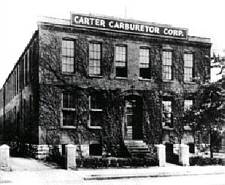 |
William "Will" Carter, circa 1950
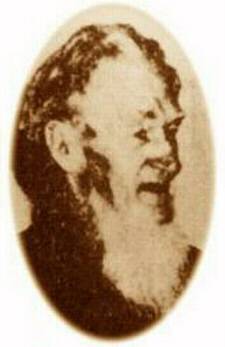 |
Carter Carburetor also supplied carburetors for the Camaro. The Carter Carburetor
Company of St. Louis, Missouri was started by William (Will) Carter in 1909. Carter
had found that the carburetor was a particular source of problems for automobile
companies and motorists alike. This prompted him to develop methods of improving fuel
delivery, beginning with wooden models that would then become cores for sand molds
and eventually, a cast-brass carburetor. Carter carburetors were acknowledged for
their superior accuracy in processing and metering fuel. In 1952, the "Will Carter
Four Barrel" (WCFB) became the world's first four-barrel carburetor and had a
whopping rating of 385 CFM! Carter was purchased in 1922 by the American Car and
Foundry Company (ACF) and continues to this day manufacturing the Carter Thermoquad carb.
Holley Carburetor, part of the Bovaird and Seyfang Building,
circa 1895
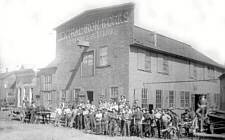 |
George Holley, circa 1901
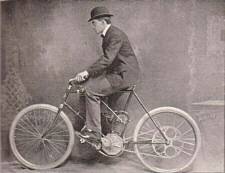 |
The third supplier for carburetors to the first-generation Camaro was Holley. The Holley
carburetor was the high performance carburetor of choice for many automotive manufacturers,
not just General Motors. Although founded in 1896 by brothers George and Earl Holley,
Holley didn't enter the automotive aftermarket until 1948. Supplying carburetors, repair
kits and genuine Holley parts to garages, service stations and speed shops around the
country, Holley began to make a name in the hot rod circles as a reliable, easy-to-adjust,
easy-to-rebuild, easy-to-modify carburetor. In 1952, a new 250,000-square-foot manufacturing
plant was opened in Bowling Green, Kentucky, and product development continued with the
first Holley modular carburetor, the model 4150 that was made standard on the 1957 Ford
Thunderbird. Chevrolet OEM use of the Holley Carburetor was generally limited to use on special
high performance engines. The 4150 carb continues to be manufactured today, with literally
millions having been sold over the years.
Rochester Carburetors
Rochester supplied four basic carburetors for the Camaro:
-
Rochester 1BV one-barrel carburetors were installed on the 1967 six-cylinder engines without
A.I.R. (Air Injection Reactor, aka smog).
The exact CFM rating of the 1BV is unknown, but it was approximately 250 CFM.
-
The Rochester "Monojet" (1MV) one-barrel carburetors were used on the 1968 and
1969 six-cylinder engines (the standard 230ci/140hp and the optional 250ci/155hp). Rated at
250 CFM, this was enough to supply ample power to the car while still achieving good gas mileage.
-
The Rochester "Dualjet" (2GV) two-barrel carburetor was used on the lower-performance
327/210hp, 307/200, and 350/250 engines. Rated at 500 CFM, this larger carburetor was necessary for
the larger displacements of the small V8 engines. It too gave ample power, while achieving
good gas mileage.
There were actually two versions of the 2GV. The SAE 1-1/4" bore version was used on
Camaros 327 and 307 engines. It can be easily identified by the fuel line inlet
being located on the side of the carburetor. The larger SAE 1-1/2" bore
version was used on 69 Camaros with the L65 350 engine. The fuel line
inlet is located on the front of the installed carburetor.
The 2GV models specified for cars with air conditioning had a "hot idle compensator" feature.
When high underhood temperatures occurred during idling, the compensator supplied
additional air to offset excessive fuel vaporization.
-
The Rochester "Quadrajet" (4MV) four-barrel carburetor was installed on medium- and
high-performance engines. This included the 327/275hp, the 350/255, the 350/295, the 350/300,
the 396/325, and the 396/350 engines. Rated at 750CFM, this was a carburetor that could deliver
good performance when the secondaries were opened, yet still retained good gas mileage under
normal conditions, due to the small primaries. Rochester carburetors were known for their
simplicity and reliability.
Rochester 1BV
Monojet Carburetor |
Rochester 1MV
Monojet Carburetor |
Rochester 2GV
Dualjet Carburetor |
Rochester 4MV
Quadrajet Carburetor |
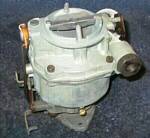
|
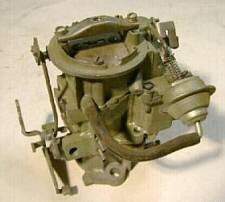
|
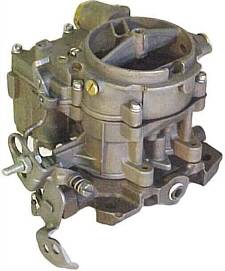
|
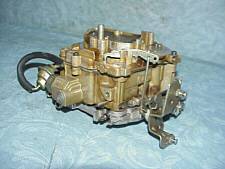
|
Carter Carburetors
The Carter "YF" single barrel carburetor was used only in 1967, and only on the six-cylinder
engines with A.I.R. (Air Injection Reactor, aka "Smog"). Other than this application, no
other "Carter designed" carburetors (AFB, AVS, WCFB or Thermoquad) were ever installed from
the factory on a first-generation Camaro. However, Carter was also licensed to build the
Quadrajet as a secondary source, and supplied carburetors to not only Chevrolet, but other
GM divisions as well. Note that all Carter-built Quadrajet carburetors will have the same
part number and ID number as the Rochester-built Quadrajets, but will have "MFG BY CARTER
CARBURETOR FOR GMC" cast into the carburetor body.
Carter YF
1-barrel Carburetor |
"MFG BY CARTER" location
|
"MFG BY CARTER" casting
|
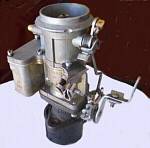
|
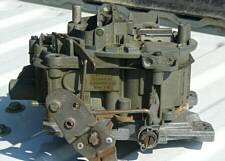
|
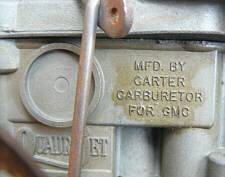
|
Holley Carburetors
Holley supplied one carburetor model for the Camaro: the tried and true 4150
series. It was standard on the special high performance (solid lifter)
302/290, 396/375 [1], and
the 427/425 engines. This carburetor was rated at 780 CFM
[2] and was a dual-feed model with
vacuum secondaries. Another version of the 4150 was also used on the 427/430 ZL1 engine,
but was rated at 850 CFM and included mechanical secondaries
[3].
Holley carburetors are known for their performance, and are not generally
thought of as an economy carburetor. However, with mild tweaking and keeping your foot
out of it, a Holley carburetor equipped engine can achieve up to 15 miles per gallon.
Horrible by today's standards, but pretty good in the late 60's!
Note that the base plates are different
between first and second design (and reproduction) carburetors. Starting in late 1970,
a new and improved thicker base plate was added to eliminate breakage or cracking when
installing. These newer base plates detract from the value of an original Holley since
an original base plate would be preferred on a restoration project. Correct base plate
assemblies can also be identified by the number "172" stamped on the 1-11/16-inch diameter
throttle blades (some may have "173" stampings).
1967 Holley
3910 Carburetor
|
1968/1969 Holley
4053 Carburetor
(Note incorrect accelerator pump
cover and screws, choke pull-off,
vent tubes, and baseplate) |
1969 Holley
4346 Carburetor
(Note incorrect primary float
adjustment screw and nut) |
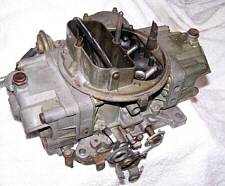
|
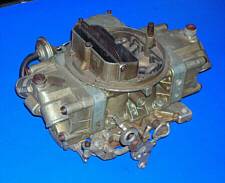
|
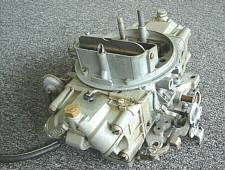
|
Detailed Pictures:
Holley "172"
stamping
|
Original Holley
Base Plate
(Driver side)
|
Later Holley
Base Plate
(Driver side)
|
Original Holley
Base Plate
(Passenger side)
|
Later Holley
Base Plate
(Passenger side)
|
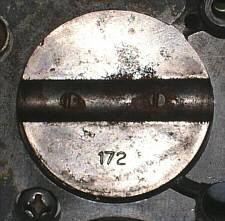
|
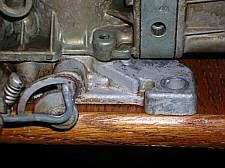
|
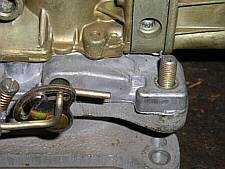
|
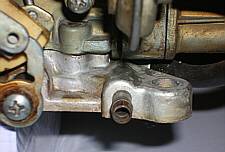
|
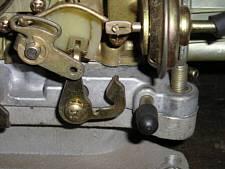
|
1967 Holley 3910
Rear view
|
1967-1969 Holley
Venturi Casting
"6R 2829"
|
1967 Holley 3910
(Driver side)
|
1967 Holley 3910
Front view
|
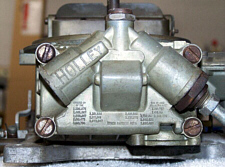
|
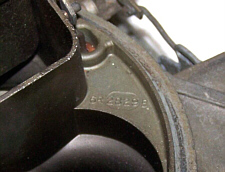
|
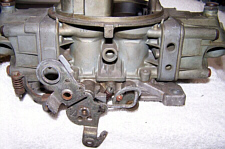
|
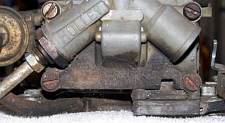 |
1967 Holley 3910
Primary Metering
Block "5417"
|
1967 Holley 3910
(Passengers side)
|
1967-1969 Holley
Correct Curved Neck
Choke Pull Off
|
1967 Holley 3910
Rear Float Bowl
and Vacuum Canister
|
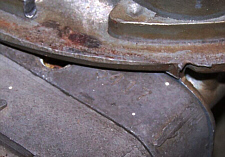 |
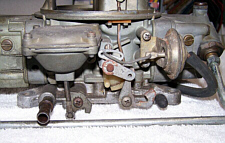 |
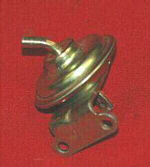
|
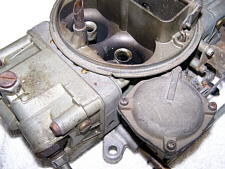
|
1968/1969 Holley
Primary Metering
Block "5583" |
1967-1969 Holley
Secondary Metering
Block "4519"
|
1967 Holley 3911
Base Plate
|
1967 Holley 3911
Base Plate
|
1967 Holley 3911
Base Plate
|
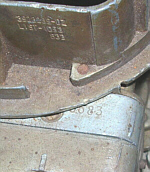
|
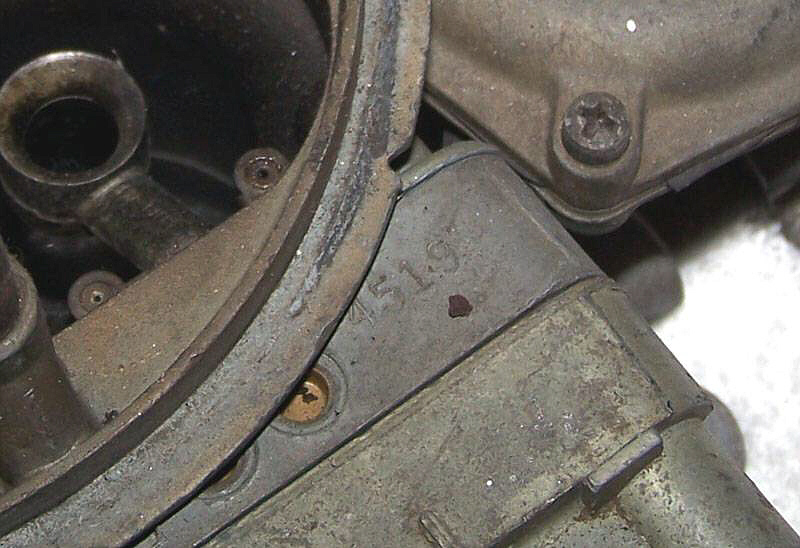
|
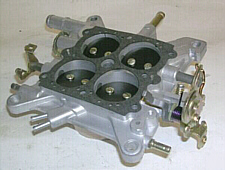
|
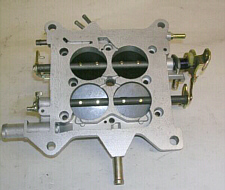
|
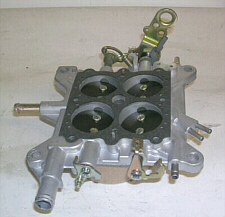
|
Date Coding and Identification
| "Bay City" casting |
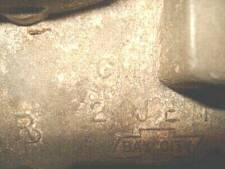
|
Carburetor date coding and identification in the late 1960's can be very confusing.
Unfortunately, since there was no requirement from General Motors dictating the structure,
each supplier was free to use the format they wanted. Making things even more
confusing was that the manufacturers didn't always stay with the same format or location.
For instance, the location of the carburetor ID stamp may be in a completely
different area from one year to the next. It also may have been different between carburetor
models from the same manufacturer. Most carburetors will have an identification number,
a broadcast code (the two letter designation that was used as "shorthand" for the complete
part number by the assembly plant), and a date code. Some will have a change letter as well,
indicating a revision of the carburetor. For instance, a change letter of "A" would indicate
the first change to the carburetor. A change letter of "B" would indicate a second change,
also incorporating the changes made in revision "A".
Not all Rochester carburetors have the "standard" seven-digit identification
code. Although uncommon, original carburetors
have been observed with the first two numbers ("70") omitted. In addition, Rochester
carburetors manufactured at the Bay City, Michigan plant can be identified by the "Bay City"
wording inside the Chevrolet bow-tie emblem cast into the carburetor body. Also note that
many of the small parts on a Rochester Quadrajet have the "RP" (Rochester Products) logo stamped
on them. The Carter-built Quadrajet carburetors won't have these stampings.
1967 Rochester Monojet (1BV) and 1967 - 1969 Rochester Dualjet (2GV)
1967 Rochester 1BV Monojet Tag Location
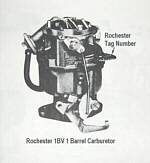 |
67-69 Rochester 2GV Dualjet
Tag Location
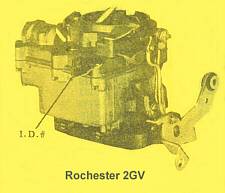 |
For these applications, the identification number, broadcast code, and date code was
located on a triangular metal (aluminum) tag attached to the front of the carburetor
on the driver's side of the car. This tag will contain not only the carburetor model
number, broadcast code, and date code in a letter/number format (where the letter is
the month of manufacture and the number is the year, e.g., C7), but also a change letter (if
applicable) and an inspection stamp. Also note that these tags were different colors,
depending on the application. This allowed assembly workers to quickly identify the correct
carburetor without having to read the tag.
1967 Rochester 2GV
7027116
M6 DA Tag
(December, 1966)
|
1968 Rochester 2GV
7028110
E8 CH Tag
(May, 1968)
|
1968 Rochester
7028112
J7 CK Tag
(September 67)
|
1969 Rochester 2GV
7029112
K8 CK Tag
(October, 1968)
|
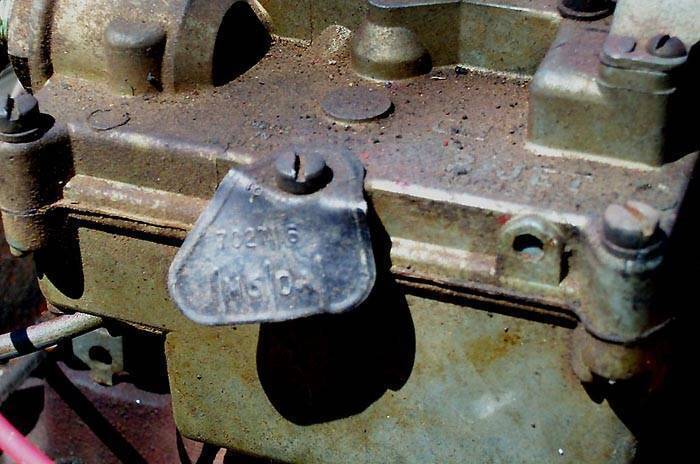
|
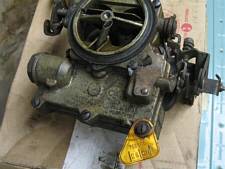
|
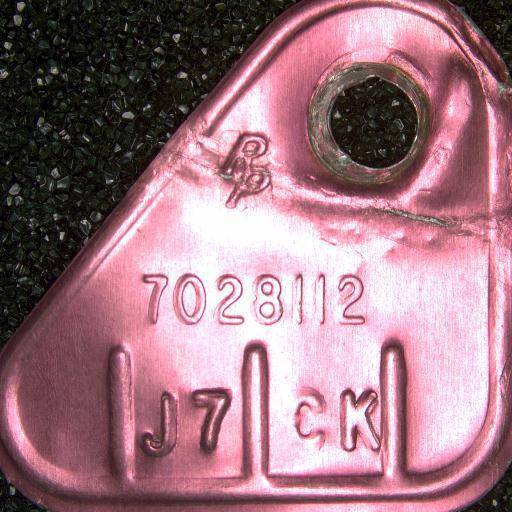
|
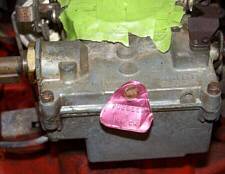 |
1967 Rochester Monojet (1MV) and 1967 Quadrajet (4MV)
1967 Rochester 1MV Monojet Tag Location
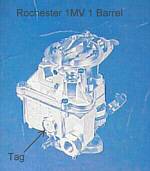 |
1967 Rochester 4MV Quadrajet Tag Location
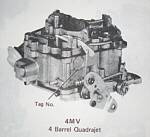 |
For 1967, the Rochester Monojet (1MV) and Rochester Quadrajet (4MV) carburetors had the
date code, identification number, change letter, and broadcast code stamped on a round
metal disk pressed into a recess on the driver's side of the main body. The date code
is again in a letter/number format where the letter is the month of manufacture and
the number is the year, e.g., C7.
The Carter-built Quadrajet carburetors will have the "MFG BY CARTER"
designation cast into the main body and used the same information location and
date code format.
1967 Rochester 4MV
ID and Date Code Example
|
1967 Rochester 4MV
ID and Date Code Example
|
1967 Carter built Quadrajet
7027203 M6 DZ Tag
(December, 1966)
(Note the"MFG BY
CARTER" casting)
|
1967 Rochester
7027211 C7 LD tag
(March, 1967)
|
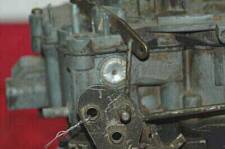
|
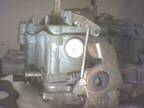
|
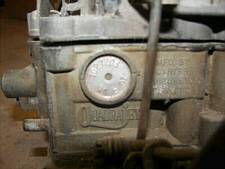
|
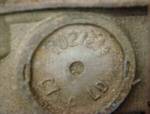
|
1968 & 1969 Rochester Monojet (1MV) and 1968 & 1969 Quadrajet (4MV)
1968/1969 Rochester 1MV Monojet Stamping Location
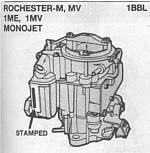 |
1968/1969 Rochester 4MV Quadrajet Stamping Location
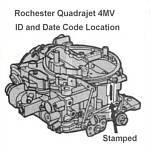 |
Starting in 1968, the Rochester Monojet (1MV) identification number was roll stamped
into the drivers side of the float bowl, along with the broadcast code.
The very early 68 Quadrajets (4MV) had the identification number, date code,
and broadcast code stamped into the round metal disk pressed into a recess
on the driver's side of the main body (like the 67 Quadrajets).
Later Quadrajet carburetors were roll stamped into the vertical
boss on the driver's side main body (just behind the secondary throttle shaft). The date
code was stamped either on the base of the carburetor toward the rear on the driver's side
of the car, or on the vertical boss next to the identification number. The date will be
in a four-digit format (where the first three numbers are the Julian day and the last
number being the year).
Carter-built 4MV Quadrajet carburetors will show the "MFG BY CARTER"
designation and continued using the date code format where the letter is the
month of manufacture and the number is the year, e.g., C8.
Early 1968 Rochester
7028212 J7 DH
(September, 1967)
|
Later 1968 Carter-built
7028212 D8 DH
(April, 1968)
(Note the "MFG BY
CARTER" & the Carter
date code format)
|
1968 Rochester
7028211 ED
|
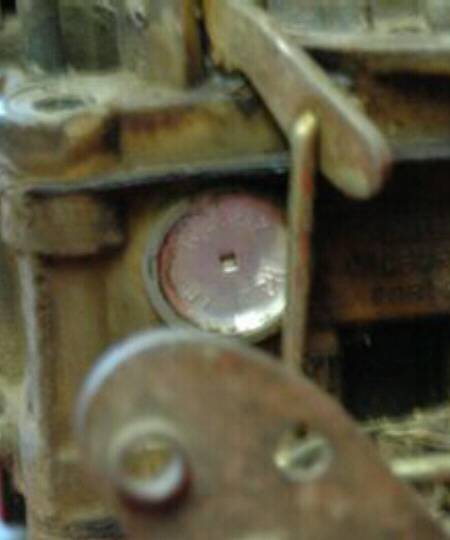
|
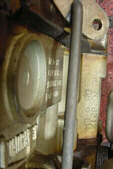
|

|
1969 Rochester
7028218 EH
|
1969 Rochester
7029202 DH 1629
(162nd day of 69)
(Note the missing "70"
in the ID number)
|
1968 Carter-built
7028213 DY A8
(January, 1968)
|
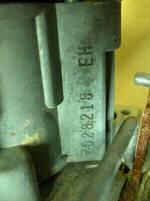
|
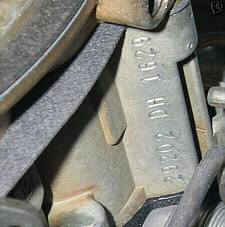
|
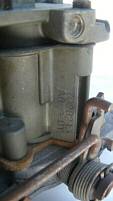
|
1967 Carter (YF) 1 barrel
1967 Carter YF Tag Location
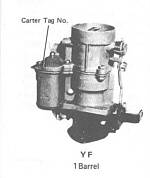 |
1967 Carter YF Stamping Location
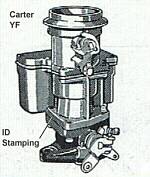 |
The identification and date code was either stamped on the lower flange of
the main body where it meets the lower mount, or on a tag attached to the float bowl. The
letter "S" followed the identification code and may have included a change code of "A", "B",
"C", etc. The date code was in a letter/number format (where the letter was the month of
production and the number was the year). The Chevrolet part number may also be present.
Note that the letter "I" wasn't used.
1967 Carter YF
Tag Location
|
1967 Carter YF Tag
3905975 4367S H6
(August, 1966)
|
1967 Carter YF
"4367S" ID number |
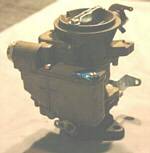
|
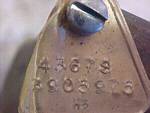
|
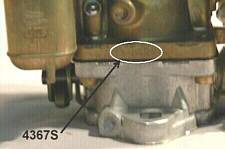
|
1967 through 1969 Holley
The identification number and the date of manufacture are stamped into the forward vertical
surface of the air horn. The three digit date code is broken down with the first number being
the year of manufacture, the second number (or letter) being the month of manufacture (1 through
0 for January through October, and then the letters A and B for November and December), and the
third number being the week of the month. Service parts assembled 1973 or later will have four
digit date codes.
1967 Holley
3916143 CT Stamping
Date code "742"
(2nd week of April, 1967)
|
1968 Holley
3923289 DZ Stamping
Date code "833"
(3rd week of March, 1968)
|
1969 Holley
3959164 GE Stamping
Date code "935"
(5th week of March, 1969)
|
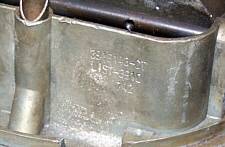
|
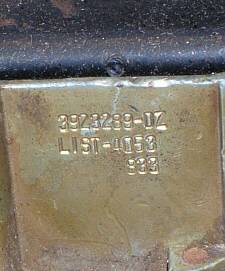
|
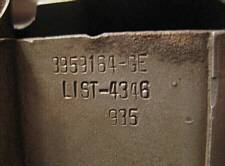
|
Chokes
To aid in cold starting the engine, all 1967-1969 Camaro carburetors had automatic
chokes that were controlled by a thermostatic coil located on the intake manifold
or exhaust manifold.
The only exception to this is the ZL1 carburetor, which did not include a choke.
Usage
The charts below show what carburetor was used in each particular engine/transmission application.
In addition to the Engine, Transmission, and Carburetor columns, there's a Chevrolet P/N column and
an ID Number column. The ID Number is the number stamped on the carburetor. You'll notice
that in some instances the Chevrolet part number and ID Number
were the same. Usually they weren't.
The Chevrolet part number is included to be able to identify an NOS carburetor or if you require parts
for a carburetor, some of which are still available from Chevrolet!
You will need the Chevrolet part number in these instances since Chevrolet references carburetors and
components using the Chevrolet part number and not the ID Number.
The "early", "mid" and "late" indications in parentheses are relative. A carburetor change could
have occurred fairly early in production, so "early" could mean only a few weeks or months into
production and "late" would mean anything after that. Or the change may have occurred near the end of
model year. If you are looking for a carburetor for an application with multiple versions,
don't go by the ID number, but by the date of the carburetor.
Both Rochester-built and Carter-built 4MV Quadrajet carburetors were supplied to the assembly plants
and were used interchangeably. The supplier didn't matter - the part number did.
Note that the same Chevrolet part number is sometimes listed for two different parts.
Unfortunately we do not have access to the original parts lists and the Chevrolet part numbers that
are shown below were derived from service information and other documentation, so we cannot
determine all the original Chevrolet part numbers.
Also note that some of the ID Numbers have the corresponding two-letter broadcast code listed.
You can help with the CRG's research on carburetors. If you know the correct broadcast
code for a carburetor that's not on the list, please contact the
.
Thanks!
1967 Carburetor Usage
| Engine |
Transmission |
Carburetor |
Chevrolet P/N |
ID Number |
| 230/140 w/o A.I.R. |
Manual |
Monojet 1BV |
7016544 |
7025003 BN |
| Automatic |
Monojet 1BV |
7016543 |
7025000 |
| 250/155 w/o A.I.R. |
Manual |
Monojet 1BV |
7016627 |
7026027 BB |
| Automatic |
Monojet 1BV |
7016628 |
7026028 BH |
230/140 w/ A.I.R.
and
250/155 w/ A.I.R. |
Manual |
Carter YF |
3905975 |
YF-4367S |
| Automatic |
Carter YF |
3905976 |
YF-4368S |
| 302/290 w/o A.I.R. |
Manual |
Holley 4150 |
3916143 |
3916143 CT
Holley # 3910 |
| 302/290 w/ A.I.R. |
Manual |
Holley 4150 |
3916145 |
3916145 CU
Holley # 3911 |
| 327/210 w/o A.I.R. |
Manual w/o A.C. |
Dualjet 2GV |
7016718 |
7027101 CA |
| Manual w/ A.C. |
Dualjet 2GV |
7016718 |
7027103 |
| Automatic w/o A.C. |
Dualjet 2GV |
7016719 |
7027110 CD (early) |
| Dualjet 2GV |
7016719 |
7027114 CL (late) |
| Automatic w/ A.C. |
Dualjet 2GV |
7016719 |
7027112 (early) |
| Dualjet 2GV |
7016719 |
7027116 DA (late) |
| 327/210 w/ A.I.R. |
Manual w/o A.C. |
Dualjet 2GV |
7037103 |
7037101 |
| Manual w/ A.C. |
Dualjet 2GV |
7037103 |
7037103 |
| Automatic w/o A.C. |
Dualjet 2GV |
7037112 |
7037110 CH |
| Automatic w/ A.C. |
Dualjet 2GV |
7037112 |
7037112 |
327/275 w/o A.I.R.
and
350/295 w/o A.I.R. |
Manual |
Quadrajet 4MV |
7034591 |
7027203 DZ (early) |
| Quadrajet 4MV |
7034591 |
7027213 DZ (late) |
| Automatic |
Quadrajet 4MV |
7016702 |
7027202 DB (early) |
| Quadrajet 4MV |
7016702 |
7027212 DB (mid) |
| Quadrajet 4MV |
7035397 |
7027218 BC (late) |
327/275 w/ A.I.R.
and
350/295 w/ A.I.R. |
Manual |
Quadrajet 4MV |
7035323 |
7037203 DY (early) |
| Quadrajet 4MV |
7035323 |
7037213 DY (late) |
| Automatic |
Quadrajet 4MV |
7037202 |
7037202 DH (early) |
| Quadrajet 4MV |
7037202 |
7037212 DH (mid) |
| Quadrajet 4MV |
7035322 |
7037218 BD (late) |
| 396/325 w/o A.I.R. |
Manual |
Quadrajet 4MV |
7016721 |
7027201 ER (early) |
| Quadrajet 4MV |
7036304 |
7027211 LD (late) [4] |
| Automatic |
Quadrajet 4MV |
7034588 |
7027200 BL (early) |
| Quadrajet 4MV |
7034588 |
7027210 BL (mid) |
| Quadrajet 4MV |
7035396 |
7027216 BL (late) |
| 396/325 w/ A.I.R. |
Manual |
Quadrajet 4MV |
7037211 |
7037201 EP (early) |
| Quadrajet 4MV |
7037211 |
7037211 EF (late) |
| Automatic |
Quadrajet 4MV |
7037210 |
7037200 EU (early) |
| Quadrajet 4MV |
7037210 |
7037210 EE (mid) |
| Quadrajet 4MV |
7036300 |
7037216 BM (late) |
| 396/375 w/o A.I.R. |
Manual |
Holley 4150 |
3916143 |
3916143 CT [1]
Holley # 3910 |
| 396/375 w/ A.I.R. |
Manual |
Holley 4150 |
3916145 |
3916145 CU [1]
Holley # 3911 |
1968 Carburetor Usage
| Engine |
Transmission |
Carburetor |
Chevrolet P/N |
I.D. Number |
230/140
and
250/155 |
Manual w/o A.C. |
Monojet 1MV |
7016823 |
7028017 BD [5] |
| Manual w/ A.C. |
Monojet 1MV |
7016823 |
7028015 [5] |
| Automatic |
Monojet 1MV |
7016822 |
7028014 BB |
302/290
and
396/375 |
Manual |
Holley 4150 |
3923289 |
3923289 DZ
Holley # 4053 |
| 302/290 (2X4) [6] |
Manual |
Holley 4160 |
3941140 |
3941140 (early)
Holley # 3810 |
| Holley 4150 |
3942595 |
3942595 (late)
Holley # 4210 |
| 327/210 w/o A.C. |
Manual |
Dualjet 2GV |
7016818 |
7028101 CG |
| Automatic |
Dualjet 2GV |
7016818 |
7028110 CH |
| 327/210 w/ A.C. |
Manual |
Dualjet 2GV |
7016819 |
7028103 |
| Automatic |
Dualjet 2GV |
7016819 |
7028112 CK |
327/275
and
350/295 |
Manual |
Quadrajet 4MV |
7016849 |
7028213 DY |
| Powerglide |
Quadrajet 4MV |
7016850 |
7028212 DH |
327/275
|
TH-350 [7] |
Quadrajet 4MV |
7016922 |
7029202 DH |
| 396/325 |
Manual |
Quadrajet 4MV |
7016817 |
7028211 ED |
| Automatic |
Quadrajet 4MV |
7016858 |
7028210 EE [8] |
| 396/350 |
Manual |
Quadrajet 4MV |
7016817 |
7028217 EG |
| Automatic |
Quadrajet 4MV |
7016858 |
7028218 EH |
1969 Carburetor Usage
| Engine |
Transmission |
Carburetor |
Chevrolet P/N |
I.D. Number |
230/140
and
250/155 |
Manual w/o A.C. |
Monojet 1MV |
7016901 |
7029017 BD [5] |
| Manual w/ A.C. |
Monojet 1MV |
7016901 |
7028015 [5] |
| Automatic |
Monojet 1MV |
7016902 |
7029014 BB |
| 302/290 |
Manual |
Holley 4150 |
3923289 |
3923289 DZ
Holley # 4053 |
| 302/290 (2X4) [6] |
Manual |
Holley 4150 |
3957859 |
3957859
Holley # 4295 |
307/200 w/o A.C.
and
327/210 w/o A.C. |
Manual |
Dualjet 2GV |
7016903 |
7029101 CG |
| Automatic |
Dualjet 2GV |
7016912 |
7029110 CH |
307/200 w/ A.C.
and
327/210 w/ A.C. |
Manual |
Dualjet 2GV |
7016903 |
7029103 |
| Automatic |
Dualjet 2GV |
7016912 |
7029112 CK |
350/250
w & w/o A.C. |
Manual |
Dualjet 2GV |
7016915 |
7029113 DC [9] |
| Automatic |
Dualjet 2GV |
7016916 |
7029114 DD [9] |
350/255
and
350/300 |
Manual |
Quadrajet4MV |
7016923 |
7029203 DY |
| Automatic |
Quadrajet 4MV |
7016922 |
7029202 DH |
396/325
and
396/350 |
Manual |
Quadrajet 4MV |
7016925 |
7029215 EH [10] |
| Automatic |
Quadrajet 4MV |
7016926 |
7029204 FF [10] |
396/375
and
427/425 (L72) |
Manual &
Automatic |
Holley 4150 |
3959164 |
3959164 GE
Holley # 4346 |
| 427/430 (ZL1) |
Manual &
Automatic |
Holley 4150 |
3955205 |
3955205
Holley # 4296 [3] |
Footnotes
Chevrolet
Service News
June 1967 |
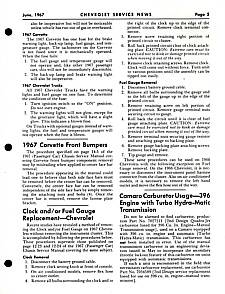 |
[1]
Although published data shows that early 1967 396/375 cars received the Holley
4160 series (list number 3811), no cars have been observed with this carburetor.
[2]
Although Holley rates this carburetor as 780 CFM, Chevrolet specifications
and advertisements showed it as 800 CFM.
[3]
Early ZL1's were produced with Holley 4346's which were later retrofitted at the Gibb
dealership with 4296's.
There is no broadcast code on the 4296. The 4296 rear accelerator pump
requires the revised air cleaner with the vent tube with two 45° bends; the version with
the 90° vent tube will hit the rear pump lever.
[5]
1968-69 6-cylinder engines with the RPO MB1 Torque Drive transmission received manual
transmission carburetors since no kickdown provision was required.
[6]
Not installed from the factory. Available as an "over the counter" service item only.
[7]
Some late 1968 327/275 cars came equipped with the Turbo 350 3-speed automatic transmission
as part of an internal GM test fleet. The carb application used a 69 part number.
[8]
The 396/350 (L34) 7028218 has also been observed on this application.
Possibly due to shortages of the 7028210.
[9]
The L65 actual observed usages are shown in the table and differ from published listings.
The listings show the L65 with AC used the 7029115 (manual trans) and 7029116 DF (auto trans) carbs.
Actual vehicle data shows that the L65 AC cars used the same carb as the L65 non-AC cars.
[10]
The L35 actual observed usages are shown in the table and differ from published listings.
Those listings show 7029200 EE as the L35 auto carb and 7029201 ED as L35 manual carb.
Neither has been observed by the CRG on original L35 cars; all have had the L34 carbs
listed above.
































